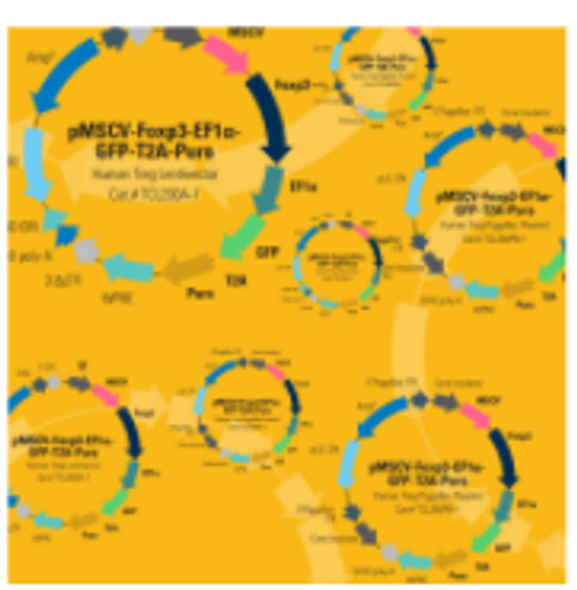System Biosciences
MSCV-Mouse Foxp3-EF1-GFP-T2A-Puro Stable Jurkat cell line (Puro resistant)
- SKU:
- TCL110C-1
- Availability:
- Usually Shipped in 5 Working Days
- Size:
- 5 x 10^6 cells/ml
- Shipping Temperature:
- Dry Ice
Description
MSCV-Mouse Foxp3-EF1-GFP-T2A-Puro Stable Jurkat cell line (Puro resistant). Cat# TCL110C. Supplier: SBI System Biosciences

Overview
- Lentivector-based for transfection-resistant cell lines

- PiggyBac Transposon-based* for infection-resistant cell lines

- Pre-built Jurkat cell line to save time and labor
- Academic Customers—End-User License Information
- Commercial Customers—End-User License Information
How It Works
A quick introduction to SBI’s lentivector packaging and PiggyBac Transposon technologies
Start producing lentivirus

The PiggyBac Transposon System’s Cut-and-Paste Mechanism
The efficient PiggyBac Transposon System uses a cut-and-paste mechanism to transfer DNA from the PiggyBac Vector into the genome. If only temporary genomic integration is desired, the Excision-only PiggyBac Transposase can be transiently expressed for footprint-free removal of the insert, resulting in reconstitution of the original genome sequence.

Figure 1. The PiggyBac Transposon System’s cut-and-paste mechanism.
-
- The Super PiggyBac Transposase binds to specific inverted terminal repeats (ITRs) in the PiggyBac Cloning and Expression Vector and excises the ITRs and intervening DNA.
-
- The Super PiggyBac Transposase inserts the ITR-Expression Cassette-ITR segment into the genome at TTAA sites.
-
- The Excision-only Super PiggyBac Transposase can be used to remove the ITR-Expression Cassette-ITR segment from the genome, for footprint-free removal
Supporting Data
Robust overexpression of Foxp3

Figure 2. SBI’s human and mouse Foxp3 lentivector and PiggyBac plasmids provide robust Foxp3 overexpression. The human and mouse Foxp3 lentivectors Cat.# TCL200A-1 (human) and Cat.# TCL100A-1 (mouse) and the PiggyBac transposon constructs Cat.# TCL200PB-1 (human) and Cat.# TCL100PB-1 (mouse) were transiently transfected into 293FT cells. After 24 hours, cellular lysates were prepared and Western blot analyses performed to detect the Foxp3 protein expression using an anti-Foxp3 antibody that detects both human and mouse proteins. Robust overexpression of both human (lanes 1,3) and mouse (lanes 2,4) Foxp3 proteins compared to the non-transfected cell lysate control (lane 5) can be clearly observed, with tubulin as a loading control.

Figure 3. SBI’s MSCV-Mouse Foxp3-EF1α-GFP-T2A-Puro Jurkat Cell Line shows strong Foxp3 overexpression. Human Jurkat T cells were transduced with either Cat.# TCL200A-1 (human) or Cat.# TCL100A-1 (mouse) pre-packaged lentivirus and stable cell lines established using puromycin selection for seven days. Overexpression of Foxp3 was evaluated by measuring GFP levels using flow cytometry and Western blot analysis of cellular lysates and using anti-Foxp3 antibody. Both methods show that SBI’s Foxp3-overexpressing Jurkat Cell Line possesses strong Foxp3 overexpression.















